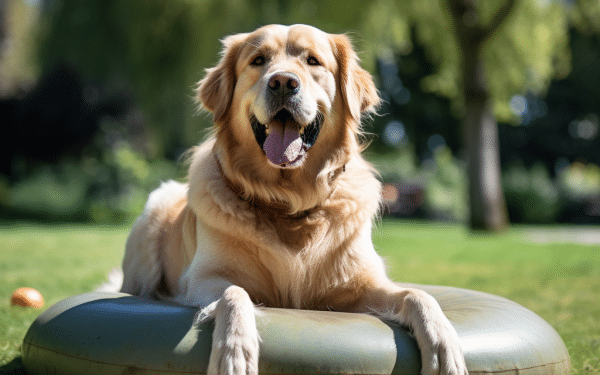Canine Obesity Management for Healthier Dogs

Dog obesity management is a crucial aspect of canine health, as it can lead to various issues such as joint problems, heart disease, and diabetes. Taking steps to address canine obesity is essential for promoting weight loss and overall well-being in dogs. Through proper diet, portion control, regular exercise, and veterinary monitoring, dog owners can effectively manage and prevent obesity in their pets, ensuring they maintain a healthy weight and live a more active life.
Understanding Canine Obesity
Canine obesity has emerged as a significant health concern, leading to a myriad of disease processes and chronic inflammatory pain in dogs. The prevalence of overweight dogs has reached alarming levels, with detrimental effects on their overall well-being. Sedentary lifestyles and unrestricted access to food contribute to excessive calorie intake and weight gain in dogs. The accumulation of fat tissue plays an active role in inflammation, leading to joint damage and osteoarthritis. It is essential to raise awareness about the risks associated with canine obesity to prevent its onset and manage existing cases effectively.
Overweight or obese dogs face a shortened lifespan due to the increased risk of developing serious health conditions. Diabetes, cancer, heart disease, and joint issues such as osteoarthritis are common health risks associated with canine obesity. The strain imposed on the body’s systems and organs by excess weight further exacerbates these risks. It is crucial for dog owners to understand that managing obesity in their pets goes beyond appearance, but is crucial for ensuring long-term health and preventing potentially life-threatening diseases.
Recognizing the factors contributing to canine obesity is paramount in developing effective prevention and management strategies. Modern dogs lead a sedentary lifestyle, lacking the physical demands of their historical working duties. Limited exercise opportunities result in reduced calorie expenditure, making weight gain more likely. Free-choice feeding, where food is available all day, enables dogs to consume more calories than they need. The surplus in calorie intake contributes significantly to weight gain and obesity. By understanding these factors, dog owners can make informed decisions to prevent and address obesity in their pets.

| Risks of Canine Obesity | Prevalence | Health Issues |
|---|---|---|
| Diabetes | High | Increased risk |
| Cancer | Moderate | Elevated incidence |
| Heart Disease | High | Higher likelihood |
| Joint Issues | Very high | Significant impact |
“The rising prevalence of canine obesity has alarming implications for the overall health and well-being of our four-legged companions.”
Factors Contributing to Dog Obesity
Several factors contribute to the prevalence of obesity in dogs. Understanding these factors is crucial in developing effective prevention and management strategies.
Sedentary Lifestyle
Dogs today lead a more sedentary lifestyle compared to their ancestors. With limited exercise opportunities and fewer working duties, dogs have reduced calorie expenditure, leading to weight gain. Regular exercise is essential to maintain a healthy weight and prevent obesity.
Unrestricted Access to Food
Free-choice feeding, where food is available all day, makes it easy for dogs to consume more calories than they need. This surplus in calorie intake contributes to weight gain and obesity. Implementing portion control and feeding dogs based on their specific nutritional needs can help prevent overeating.
Excessive Calorie Intake
Dogs can consume excessive calories through treats, table scraps, and high-calorie dog food. These extra calories contribute to weight gain. Limiting treats, opting for healthier alternatives, and selecting dog food with appropriate calorie content can help manage calorie intake and prevent obesity.
| Factors Contributing to Dog Obesity | Impact |
|---|---|
| Sedentary Lifestyle | Dogs have reduced calorie expenditure, leading to weight gain |
| Unrestricted Access to Food | Dogs can overeat and consume more calories than needed |
| Excessive Calorie Intake | Dogs consume extra calories through treats and unhealthy food choices |
Prevention of Dog Obesity
Preventing obesity in dogs requires a proactive approach that focuses on appropriate food choices, portion control, and the use of interactive feeding toys. By implementing these strategies, dog owners can help their pets maintain a healthy weight and prevent the development of obesity-related health issues.
Appropriate Food Choices
One of the key components of preventing dog obesity is selecting the most suitable food for your furry friend. Different life stages and nutritional needs require specific dietary formulations. Puppies, adult dogs, and senior dogs have varying requirements that should be met with age-appropriate food choices. Consult with your veterinarian to determine the best diet for your dog’s individual needs.
Portion Control
Controlling portion sizes is crucial in preventing overfeeding and weight gain. Many dog food bags overestimate the amount of food a dog needs, leading to excessive calorie intake. It’s essential to measure portions accurately and adjust them as necessary based on your dog’s activity level and body condition. Consult with your veterinarian to determine the appropriate portion sizes for your dog’s specific needs.
Interactive Feeding Toys
Engaging your dog in interactive feeding can help slow down eating and increase calorie expenditure. Interactive feeding toys, such as treat-dispensing puzzles or slow-feeders, provide mental stimulation and physical activity while consuming food. These toys make mealtime more engaging and challenging, promoting a healthier eating pace and preventing excessive food intake. Incorporating interactive feeding toys into your dog’s routine can contribute to weight management and overall well-being.
| Benefits of Prevention Strategies | How to Implement |
|---|---|
| Prevents overfeeding and excessive calorie intake | Measure food portions accurately |
| Promotes a healthy weight and body condition | Select appropriate food choices for your dog’s life stage |
| Increases mental stimulation and physical activity | Introduce interactive feeding toys during mealtime |
By focusing on appropriate food choices, portion control, and interactive feeding toys, dog owners can take active steps in preventing obesity and promoting a healthier lifestyle for their furry companions.
Health Risks of Canine Obesity
Canine obesity poses significant health risks for dogs, increasing their vulnerability to various diseases and conditions. Dogs that are overweight or obese have a higher risk of developing diabetes, cancer, heart disease, and joint issues such as osteoarthritis.
Excess weight places added strain on the body’s systems and organs, leading to an increased likelihood of developing these health problems. Diabetes, for example, is more prevalent in obese dogs due to the negative impact of excess fat tissue on insulin sensitivity. Similarly, cancer rates are higher in dogs with obesity, possibly due to chronic inflammation and the disruption of hormonal balance.
Heart disease and joint issues are also common in obese dogs. The extra weight places additional stress on the heart, increasing the risk of heart failure and other cardiovascular problems. Joint problems arise from the strain that excess weight places on the bones and joints, leading to pain, reduced mobility, and a decreased quality of life for the dog.
| Health Risks of Canine Obesity | Prevalence |
|---|---|
| Diabetes | Higher risk in obese dogs due to reduced insulin sensitivity |
| Cancer | Elevated cancer rates correlated with obesity and chronic inflammation |
| Heart Disease | Excess weight places additional strain on the heart |
| Joint Issues | Increased risk of osteoarthritis and chronic joint pain |
Managing canine obesity is not just about appearance but also about ensuring the long-term health and well-being of dogs. By addressing and preventing obesity, dog owners can help their pets avoid these potentially life-threatening conditions and provide them with a better quality of life.
Tips for Assessing Dog Weight and Body Condition
Assessing a dog’s weight and body condition is an important step in managing and preventing obesity. By using a combination of visual and hands-on techniques, pet owners can determine whether their dogs are at a healthy weight or if they need to make adjustments to their diet and exercise routine.
One method of assessing body condition is by feeling the ribs and hips. When running your hands along your dog’s sides, you should be able to feel the ribs without them being too prominent or invisible. There should also be a slight layer of fat covering the ribs. Similarly, when running your hands over the hips, you should be able to feel the bony prominence but with a small amount of padding. This gentle padding indicates a healthy weight.
Another visual cue for a healthy body condition is a distinct waistline or a tucked area before the back legs. When viewing your dog from above, there should be a noticeable inward curve where the ribcage ends and the waistline begins. This indicates a proper weight and body shape. However, it’s important to consider breed variations when assessing body condition. Different breeds may have different ideal weights and body shapes, so it’s essential to consult breed-specific guidelines or consult with a veterinarian for guidance.
| Breed | Ideal Weight | Body Shape |
|---|---|---|
| Labrador Retriever | 55-75 pounds | Moderately defined waistline |
| Pug | 14-18 pounds | Less defined waistline due to body shape |
| Border Collie | 30-45 pounds | Distinct waistline |
Regular veterinary check-ups are also valuable for assessing a dog’s weight and overall health. Veterinarians have experience and expertise in evaluating body condition and can provide guidance on appropriate weight management strategies tailored to each individual dog’s needs.
Common Causes of Dog Obesity
In today’s society, overeating, over-treating, and a lack of exercise are the most common causes of obesity in dogs. Many dog owners, out of love and kindness, tend to overfeed their furry companions, often providing them with excessive amounts of food or treats. Free-choice feeding, where food is constantly available, can also contribute to overeating. Coupled with a sedentary lifestyle and limited exercise opportunities, these factors lead to weight gain and obesity in dogs.
To address these common causes, it is crucial for dog owners to establish proper portion control and monitor their pet’s calorie intake. It’s essential to consult with a veterinarian to determine the appropriate amount of food for the dog’s specific needs. By following a balanced diet, providing healthy treats in moderation, and engaging in regular exercise, owners can help their dogs maintain a healthy weight.
Recognizing the importance of exercise is vital in preventing and managing obesity. Daily physical activity not only helps dogs burn calories but also promotes mental well-being. Activities such as walking, playing fetch, or participating in interactive games can contribute to weight management and overall health. It is recommended to incorporate exercise routines into daily life and make it a priority for the dog’s well-being.
Common Causes of Dog Obesity:
To summarize, the common causes of dog obesity are:
- Overeating: Providing excess food or treats beyond the dog’s dietary needs.
- Over-treating: Offering too many treats or unhealthy snacks.
- Lack of exercise: Failing to provide regular physical activity opportunities for dogs.
By addressing these causes and implementing appropriate strategies, dog owners can help their pets maintain a healthy weight and prevent the detrimental effects of obesity.
| Causes of Dog Obesity | Effects |
|---|---|
| Overeating | Weight gain, increased risk of health issues |
| Over-treating | Excessive calorie intake, potential nutrient imbalance |
| Lack of exercise | Reduced calorie expenditure, muscle weakness |
Strategies for Weight Loss in Dogs
To facilitate weight loss in overweight or obese dogs, several strategies can be implemented. By reducing meal sizes, improving food quality, and limiting treats, dog owners can help their pets achieve a healthier weight.
- Reduce Meal Sizes: Controlling portion sizes is crucial in calorie reduction. Dog owners can consult with a veterinarian to determine the appropriate amount of food for their dog’s specific needs. Gradually reducing meal sizes and monitoring weight loss progress can help achieve the desired results.
- Improve Food Quality: Opting for higher-nutrient dog food options can promote weight loss while ensuring essential nutrients are met. Look for brands that offer balanced formulations, with appropriate levels of protein, fiber, and healthy fats. Avoid foods that contain excessive fillers, artificial additives, or unhealthy ingredients.
- Limit Treats: Treats are often high in calories and can contribute to weight gain. Instead of offering numerous treats throughout the day, focus on using them as rewards during training sessions or special occasions. Choose healthy, low-calorie treats or consider making homemade treats with quality ingredients and controlled portion sizes.
Implementing these strategies should be done in consultation with a veterinarian to ensure they are appropriate for each individual dog’s needs. Regular monitoring of weight, body condition, and overall health is also essential for successful weight loss.
Making Homemade Treats for Dogs
When it comes to treating our furry friends, making homemade treats can be a great way to ensure their health and happiness. By using quality ingredients and practicing portion control, dog owners can provide their pets with delicious snacks that contribute to weight management. Homemade treats offer the advantage of customization, allowing owners to tailor them to their dog’s specific dietary needs and taste preferences. Plus, they are a fun and rewarding activity for both the dog and their human companion.
To ensure healthy homemade treats, it’s important to choose ingredients that are safe and nutritious for dogs. Simple recipes using ingredients like chicken, peanut butter, and banana can be a hit with most dogs. Avoid using ingredients that are toxic to dogs, such as chocolate, grapes, and onions. Additionally, consider any specific dietary restrictions or allergies your dog may have when selecting ingredients for homemade treats.
Portion control is key when it comes to homemade treats. While they may be healthier than store-bought options, it’s still important to keep track of the amount you’re giving your dog. Treats should make up no more than 10% of a dog’s daily caloric intake. By using small cookie cutters or breaking treats into bite-sized pieces, you can ensure that your dog receives the right amount without overindulging. Regularly monitoring your dog’s weight and consulting with a veterinarian can provide further guidance on portion control and homemade treat options.
Homemade Treats
| Treat Recipe | Ingredients | Instructions |
|---|---|---|
| Chicken Jerky | Chicken breast | 1. Preheat oven to 200°F (93°C). 2. Slice chicken breast into thin strips. 3. Place strips on a baking sheet lined with parchment paper. 4. Bake for 2-3 hours or until jerky is firm and dry. 5. Allow jerky to cool before serving. |
| Peanut Butter Banana Bites | Peanut butter, banana | 1. Mash a ripe banana in a bowl. 2. Add 1-2 tablespoons of peanut butter and mix well. 3. Drop spoonfuls of the mixture onto a baking sheet. 4. Freeze for a few hours or until firm. 5. Serve frozen or slightly thawed. |
| Berry Frozen Yogurt Treats | Plain yogurt, berries (strawberries, blueberries, raspberries) | 1. Mix plain yogurt with chopped berries in a bowl. 2. Spoon the mixture into silicone ice cube trays or molds. 3. Freeze for a few hours or until solid. 4. Pop out the frozen treats and serve. |
Remember, homemade treats should be enjoyed in moderation as part of a balanced diet. Pair them with regular exercise and a nutritious dog food to ensure your four-legged friend stays healthy and maintains a proper weight. Making homemade treats is not only a great way to bond with your dog but also to provide them with wholesome and tasty rewards that contribute to their overall well-being.
Importance of Exercise for Weight Management
Regular exercise plays a vital role in weight management for dogs. Physical activity not only helps burn calories but also promotes mental well-being. Dogs require exercise to maintain their overall health and prevent weight gain. Activities such as walking, playing fetch, and engaging in interactive games provide opportunities for dogs to burn calories and expend energy. Incorporating exercise routines into daily life is essential for ongoing weight management and overall well-being.
Exercise not only helps dogs maintain a healthy weight but also has numerous benefits for their mental well-being. Just like humans, dogs need mental stimulation and a sense of purpose in their daily lives. Regular exercise can improve their mood, reduce anxiety, and prevent behavioral problems associated with boredom. It provides an outlet for their natural instincts and energy, keeping them physically and mentally stimulated.
Increased calorie expenditure through exercise is an effective way to support weight management in dogs. When coupled with a balanced diet, exercise helps create a calorie deficit, leading to weight loss. Consistency is key, and dog owners should aim for at least 30 minutes of moderate to vigorous exercise daily, depending on their dog’s breed, age, and overall health. It is important to consult with a veterinarian to determine the appropriate exercise routine for each individual dog.
| Benefits of Exercise for Dogs |
|---|
| Helps maintain a healthy weight |
| Promotes mental well-being and reduces anxiety |
| Prevents behavioral problems associated with boredom |
| Provides an outlet for natural instincts and energy |
| Improves cardiovascular health and overall fitness |
| Strengthens muscles and joints |
Key Strategies for Incorporating Exercise into a Dog’s Routine
- Regular walks or runs in the neighborhood or local park
- Engaging in interactive games such as fetch or tug-of-war
- Exploring new environments through hiking or exploring nature trails
- Participating in dog sports or agility training
- Using puzzle toys or treat-dispensing toys to stimulate mental and physical activity
The Role of Probiotics in Obesity Prevention
Research suggests that maintaining a balanced intestinal microflora plays a significant role in preventing obesity in dogs. Probiotics, which are beneficial bacteria, have shown promising effects on weight management by improving nutrient absorption and promoting a diverse and healthy microbiome. When combined with a balanced diet and portion control, probiotic supplementation can support efforts to prevent and manage obesity in dogs.
A balanced intestinal microflora is essential for overall health and proper digestion in dogs. Probiotics help maintain this balance by colonizing the gut with beneficial bacteria that can outcompete harmful bacteria. These beneficial bacteria aid in the breakdown and absorption of nutrients from food, leading to improved nutrient utilization and reduced fat storage. By enhancing nutrient absorption, probiotics can contribute to weight management in dogs.
“Probiotics play a key role in weight management for dogs by improving nutrient absorption and promoting a diverse microbiome.”
Furthermore, probiotics promote a diverse microbiome, which refers to the variety of microorganisms present in the gut. A diverse microbiome is associated with better overall health and lower risk of obesity. Studies have shown that dogs with a higher microbiome diversity tend to maintain a healthier weight compared to those with a less diverse microbiome. By increasing microbiome diversity, probiotics can help prevent the development of obesity and its associated health risks.
Consulting with a veterinarian is crucial when considering probiotic supplementation for dogs struggling with obesity. A veterinarian can recommend specific probiotic strains and guide dog owners on the appropriate dosage and duration of supplementation. It is important to remember that probiotics should complement a balanced diet, portion control, and regular exercise as part of an overall weight management plan for dogs.
| Benefits of Probiotics in Obesity Prevention | Weigh Management Strategies |
|---|---|
| Improved nutrient absorption | Reducing meal sizes |
| Increased microbiome diversity | Improving food quality |
| Enhanced digestion | Limiting treats |
| Reduced fat storage | Consulting with a veterinarian |
Conclusion
Managing and preventing obesity in dogs is crucial for their overall health and well-being. By implementing strategies such as proper diet, portion control, regular exercise, and veterinary monitoring, dog owners can ensure their pets maintain a healthy weight. By addressing the causes of obesity and taking proactive steps, we can prevent the development of associated health risks and ensure our dogs live a healthier, more active life free from the burdens of obesity.
Obesity in dogs is a significant health concern that can lead to various issues such as joint problems, heart disease, and diabetes. However, it is preventable and reversible. By understanding the factors contributing to canine obesity, such as sedentary lifestyles and unrestricted access to food, dog owners can make informed decisions to prevent weight gain in their pets.
It is important to be aware of the health risks associated with canine obesity, including an increased risk of developing diabetes, cancer, heart disease, and joint issues. Managing obesity in dogs is not just about appearance but also about ensuring long-term health and preventing potentially life-threatening diseases.
Regular exercise, along with a balanced diet and portion control, plays a vital role in weight management for dogs. Engaging in physical activities helps burn calories, promotes mental well-being, and prevents weight gain. By incorporating exercise routines into daily life, dog owners can contribute to their pets’ ongoing weight management and overall well-being.
FAQ
How can I prevent obesity in my dog?
You can prevent obesity in your dog by selecting the most appropriate food for their specific life stage, practicing portion control, providing regular exercise, and monitoring their weight with the help of a veterinarian.
What health risks are associated with canine obesity?
Canine obesity is associated with an increased risk of developing diabetes, cancer, heart disease, and joint problems such as osteoarthritis. Excess weight places additional strain on the body’s systems and organs, leading to a higher likelihood of developing these conditions.
How do I assess my dog’s weight and body condition?
You can assess your dog’s weight and body condition by feeling their ribs and hips to determine whether there is an appropriate amount of fat covering them. Additionally, observing a distinct waistline or tucked area before the back legs can indicate a healthy body condition. Breed variations should also be considered when assessing body condition.
What are the common causes of obesity in dogs?
The most common causes of obesity in dogs are overeating, over-treating, and a lack of exercise. Dogs often ask for food or treats, and the love and kindness of their owners can lead to overfeeding. Free-choice feeding and excessive treat consumption contribute to weight gain. Additionally, a sedentary lifestyle with limited exercise can further exacerbate the problem.
How can I help my overweight dog lose weight?
To facilitate weight loss in overweight or obese dogs, you can reduce meal sizes by controlling portion sizes, improve the quality of their food, limit treats and opt for healthier alternatives, and consult with a veterinarian to determine the appropriate approach for their specific needs.
Can I make homemade treats for my dog?
Yes, making homemade treats for your dog can be a healthier alternative to store-bought options. By using quality ingredients and controlling portion sizes, you can provide treats that are not only tasty but also contribute to weight management. Simple homemade treats can include ingredients such as chicken or peanut butter and banana.
How important is exercise for weight management in dogs?
Regular exercise plays a vital role in weight management for dogs. Physical activity helps burn calories and promotes mental well-being. Dogs require exercise to maintain their overall health and prevent weight gain. Activities such as walking, playing fetch, and engaging in interactive games provide opportunities for dogs to burn calories and expend energy.
What is the role of probiotics in obesity prevention for dogs?
Research suggests that maintaining a balanced intestinal microflora can aid in obesity prevention in dogs. Certain probiotic strains have been shown to positively impact weight loss by improving nutrient absorption and promoting a diverse microbiome. Probiotic supplementation, when combined with a balanced diet, can support weight management efforts and contribute to overall health.







